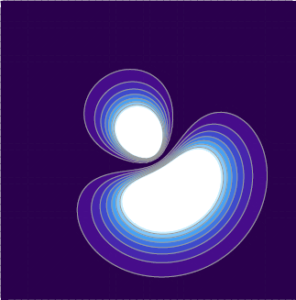The course.
This page describes my class notes from the fall 2013 session of the University of Toronto Condensed Matter Physics course (PHY487H1F), taught by Prof. Stephen Julian, which I took as a non-degree student.
The official course description at the time was:
Introduction to the concepts used in the modern treatment of solids. The student is assumed to be familiar with elementary quantum mechanics. Topics include: bonding in solids, crystal structures, lattice vibrations, free electron model of metals, band structure, thermal properties, magnetism and superconductivity (time permitting)
Mathematica notebooks associated with the class are also available.
The book.
My notes for this class (335 pages, 6×9″) for that class are available in a few formats:
- In paperback or hardcover (black and white) using Amazon’s print-on-demand service (Kindle Direct Publishing.)
- In color, for free as a PDF.
- From leanpub as an e-book for $5+ (pick your own price.) A forum for the book is also available on leanpub.
- from github as latex, scripts, and makefiles (below)
The paper version is missing a couple sub-problems from chapter I, as the figures were too complicated (or large?) for kindle-direct-publishing to process.
Contributing.
Should you wish to actively contribute typo fixes (or additions, editing, …) to these notes, you can do so by contacting me, or by forking your own copy of the associated git repositories and building the book pdf from source, and submitting a subsequent merge request.
git clone [email protected]:peeterjoot/latex-notes-compilations.git peeterjoot cd peeterjoot submods="figures/phy487-qmsolids phy487-qmsolids mathematica latex" for i in $submods ; do git submodule update --init $i (cd $i && git checkout master) done export PATH=`pwd`/latex/bin:$PATH cd phy487-qmsolids make
I reserve the right to impose dictatorial control over any editing and content decisions, and may not accept merge requests as-is, or at all. That said, I’ll probably not refuse reasonable suggestions or merge requests.
Contents:
- Copyright
- Document Version
- Dedication
- Preface
- Contents
- List of Figures
- Lecture Notes
- 1 Bonding
- 1.1 Chemical bonding in solids
- 1.2 Covalent bonding
- 1.3 Ionic bonding
- 1.4 Metallic bonding
- 1.5 Transition metals
- 1.6 Problems
- 2 Lattice structure and diffraction
- 2.1 Periodicity
- 2.2 Crystal structures
- 2.3 Point group symmetry
- 2.4 Simple crystal structures
- 2.5 General theory of diffraction
- 2.6 Reciprocal lattice
- 2.7 Constructive interference
- 2.8 Ewald sphere
- 2.9 Scattering in terms of lattice points
- 2.10 Bragg condition
- 2.11 Structure factor
- 2.12 Brillouin zones
- 2.13 Problems
- 3 Phonons
- 3.1 Phonons
- 3.2 3D potentials for real solids
- 3.3 Problems
- 4 Thermal properties
- 4.1 Thermal properties
- 4.2 lattice energy
- 4.3 Density of states
- 4.4 Isotropic model (Debye)
- 4.5 Thermal energy of a harmonic oscillator
- 4.6 Lattice specific heat capacity
- 4.7 Problems
- 5 Free electron model
- 5.1 Free electron model of metals
- 5.2 Fermi Dirac distribution for T > 0
- 5.3 Heat capacity of free electrons
- 5.4 Thomas-Fermi screening
- 5.5 Problems
- 6 Electronic bandstructure
- 6.1 Electrons in a periodic lattice
- 6.2 Nearly free electron model
- 6.3 Tight binding model
- 6.4 Three dimensional band structures, Fermi surfaces of real metals
- 6.5 Problems
- 7 Electrical conductivity
- 7.1 Semiconductors
- 7.2 Density of states
- 7.3 Electrical transport
- 7.4 Electric current
- 7.5 Problems
- 8 Electron scattering
- 8.1 Electron-phonon scattering
- 8.2 Electron-electron scattering
- 9 Semiconductor physics
- 9.1 Conduction and valence bands
- 9.2 Doped semiconductors
- 9.3 Problems
- 10 Superconductivity
- 10.1 Superconductivity overview
- 10.2 London equations, and perfect conductors
- 10.3 Cooper pairing
- 10.4 BCS theory
- Appendixes
- A Huygens diffraction
- B Discrete Fourier transform
- C Exponential solutions to second order linear system
- C.1 Motivation
- C.2 Matrix methods
- C.3 Fourier transform methods
- C.4 Reflection
- D Fourier coefficient integral for periodic function
- E Mathematica notebooks
- Bibliography
Changelog:
V0.1.10: Sept 12, 2020 (commit 1828519052459263d94bc2f5e9cc46df843a7d24):
- Update email address.
- Add spellcheck rules and run a spellcheck pass.
- Switch to classicthesis_mine/backmatter2.tex
- Fix hyphenation in listing.
- Remove dup sequential words.
- Purge dmath+aligned.
V0.1.9: March 24, 2019 (commit 02c48bcf7152255bd7f16b4ee4928573d3444bcc):
- Switch to 6×9 format for Kindle Direct Publishing.
- Remove blanks before and after equations. Some may be appropriate but most are not.
- Add punctuation (periods, commas) in equations, figures, chapter, section, problems, …
- Fix pdfbookmarks for contents and list of figures (so that they don’t show up under the preface.)
- Handle equations that were spilled out of printable regions.
- Narrow the Block’s table (still not ideal, but better).
- Suppress the cool density plot figures in chapter 1, problem 2. Not compatible with kdp.
